Gaming In The Vietnam War – 50th Anniversary Of The Tet Offensive: Part Four
February 12, 2018 by oriskany
Once again, fellow wargamers and history buffs, it’s time to continue our article series commemorating the 50th Anniversary of the “Tet Offensive” in the Vietnam War. As we’ve seen, this offensive was a massive series of surprise communist assaults launched across South Vietnam, timed for the Vietnamese “Tet” New Year holiday.
Read The Gaming In Vietnam Series Here
So far we’ve reviewed the overall communist plan for Tet in Part One, looked at the opening guerrilla-style assaults near Saigon in Part Two, and reviewed the more conventional attacks further north near the Demilitarized Zone (DMZ) in Part Three.
Now we’ll see the Americans and their allies start their inevitable counterassault, pushing back against everything the communists had seized in the surprise opening of their offensive. With the Americans on the attack against an often-hidden foe, this is where our Vietnam games become a little more typical of the “expected” Vietnam model.
The Battle For Hue
A Different Kind Of Jungle
As reviewed in previous articles, the Tet Offensive struck hundreds of targets across South Vietnam starting on January 30th, 1968. The idea was to create a crisis of confidence in the South Vietnamese government and ignite a popular uprising. The new communist government in Saigon would demand an immediate US withdrawal.
It was for this reason that the brunt of the first wave attacks at Tet didn’t actually hit big US forces out in the countryside (Khe Sanh and other DMZ combat bases being notable exceptions). Instead, the communists hit the civilian cities, exploiting the poor readiness of the South Vietnamese army with maximum surprise.
One of the biggest single attacks in the Tet Offensive was aimed at the old imperial capital of Vietnam: the city of Hue. Here, the People’s Army of Vietnam (usually known as the North Vietnamese Army or NVA) and the National Liberation Front (NLF or Viet Cong) combined forces to take almost the entire city in an overwhelming blitz.
In all, the NVA and Viet Cong committed a combined 12,000 troops, including two full NVA regiments (6th Regiment of the 325C Division, 4th Independent Regiment) and at least two local Viet Cong battalions (12th and 402nd). They took the city almost immediately, but to re-take it would involve the largest single engagement of the Tet Offensive.
Right from the outset, the Americans and South Vietnamese in Hue were on the back foot. The entire city was only garrisoned by two HQ units (ARVN 1st Division and the American MACV – Military Assistance Command, Vietnam). Surrounded and outnumbered dozens-to-one, these HQ units desperately needed help.
US Marine Corps units of the 2nd Battalion/5th Marine Regiment were among the first to get into the city, along with the elite South Vietnamese “Black Panther” battalion. The US Army also tried to get units of the elite 1st Air Cavalry Division engaged, but the Tet Offensive had caught the troops cut off from their supplies and artillery support.
Steadily, more and more ARVN, USMC, and US Army troops pried their way into the city and joined the battle. The fighting was positively savage, with firefights chewing through tight streets, courtyards, and apartment blocks. One could almost call it the “Stalingrad” of Vietnam.
By the end of the first week of February, the communists had realized that the Tet Offensive had largely failed and so started ordering their surviving units to fall back into the countryside. One of the few exceptions was Hue, its symbol as the cultural centre of historic Vietnam was too great. Hue would be held, or else.
At first, South Vietnamese authorities demanded that no air strikes or heavy artillery be used in clearing the dense districts of Hue City, collateral damage on cultural landmarks would be too great. As casualties mounted, however, American artillery, air strikes, and even naval gunfire from US Navy warships rained down on Hue.
Huge sections of the city were laid waste, and civilian casualties were steep (in addition to several thousand who’d already been executed when the communists took the city on January 31st). The NVA pulled back to the “Citadel,” the old Imperial Palace on the north side of the Perfume River, blowing up the bridges behind them.
This didn’t stop the Marines. Supply, reinforcement, and gunfire support were soon pouring off landing craft in the Perfume River, as fortified NVA positions in the Citadel were bombarded and assaulted.
The Tet Offensive had caught the 1st AirCav Division in midst of a redeployment, and when the NVA cut the Route 1 highway into Hue, the division’s assets were caught on opposite sides of the city. But as they regained their balance, the 1st AirCav (especially 12th Regiment) proved an invaluable asset in cutting off and grinding down the NVA in Hue.
In the end, fighting in Hue would not end until early March 1968. Technically the battle was an allied victory, but 142 Marines had been killed and 857 seriously wounded. Over 400 ARVN troops had been lost, along with at least 5,000 NVA and Viet Cong. Over 5,000 civilians had also been killed either in the fighting or communist executions.
ANZACs Move Into Action
1st Australian Task Force
Although northern battles like Hue City and Khe Sanh would see weeks of ferocious fighting (Operation Scotland being the defence of Khe Sanh, Operation Pegasus the counterattack and relief effort) massive counterassaults were in fact in progress all across South Vietnam, aimed at rolling back communist gains in the Tet Offensive.
As we’ve mentioned several times, the US and South Vietnamese were just the majority of the Free World forces engaged in the Vietnam War, including the Tet Offensive. Another contingent was the 1st Australian Task Force, originally made up of three Australian battalions before being reinforced with New Zealanders and tanks.
The 1st ATF was stationed in the Phuoc Tuy province, east of Saigon, part of ARVN’s III Corps tactical zone (nominally 1st ATF was under command of US II Field Force). The Tet Offensive caught them in the midst of Operation Coburg, a series of search-and-destroy missions, triggered by warning signs that a major communist attack was coming.
Although intelligence had warned that some kind of communist offensive was imminent, the scale, direction, and timing of Tet caught everyone off balance. The 1st ATF’s operations were too late to prevent the NLF/Viet Cong’s attacks into Saigon, but they were perfectly positioned to cut off communist retreat from Long Binh and Bien Hoa.
You may recall frompart two of this series where we saw the 274th and 275th Regiments of the 5th NLF Division hit the American bases at Long Binh and Bien Hoa. Well, that battle had now been won and the remnants of these Viet Cong forces were trying to withdraw. Too bad the ANZACs were already waiting for them at the back door.
These forces included 2nd and 7th Battalions / Royal Australian Regiment (2 RAR and 7 RAR), backed up by Centurion tanks of the A Squadron, 3rd Cavalry Regiment. They were supported by two batteries of 4th Royal Australian Artillery and two companies (“Victor” and “Whiskey”) of the New Zealand Regiment (attached to 2 RAR).
Since Tet had started, these forces had been re-deployed by air to the Dong Nai province (closer to Long Binh and Bien Hoa), and had been pushing hard to occupy key ground at places like Trang Bom. From here, they could interdict elements of the 5th NLF Division as they tried to disengage from the Americans.
Charlie Company, 7 RAR was engaged in particularly heavy fighting, running into deeply dug-in positions north of Trang Bom on 5th February 1968. This is the battle we’ve tried to recreate somewhat in our “Vietnam Edition” of Barry Doyle’s Valor & Victory system.
Other units of the 1st ATF were engaged all across the Phouc Tuy and Dong Nai provinces. Fire support bases (FSBs) were deliberately set up along enemy routes of retreat from Saigon, Long Binh, and Bien Hoa, and came under desperately ferocious attack as the NLF fought to escape the trap.
Not many of them made it. Once the 1st ATF had established these blocking positions, the Viet Cong found it impossible to dislodge them and scraped past them only at a horrific cost. The fierce combat lasted until the end of February 1968, by which time the 1st ATF had made a major contribution to breaking the Tet Offensive.
For their involvement in this action, the Royal Australian Regiment and the 3rd Cavalry would be awarded the “Bien Hoa” unit citation for their regimental colours.
Rolling Back The Tet Offensive
While the battles of the Tet Offensive all started with explosive, near-simultaneous surprise, they ended in slow, struggling whimpers. Gradually, painfully, and bloodily, pockets of Viet Cong and NVA resistance were either driven out of their Tet Offensive objectives or annihilated where they stood.
In addition to the longer battles discussed at Hue City and Khe Sanh, other “fires” continued to smoulder as the Tet Offensive was steadily smothered out. Another of these lingering trouble spots was at Cholon, a predominantly Chinese suburb in the south part of Saigon.
The Battle of Saigon had turned very quickly. Although the first shock of the fighting was almost entirely absorbed by South Vietnamese forces (with the very small yet painfully visible exception of the attack on the US Embassy), US forces were quickly mobilized to stabilize the situation.
APCs and tanks spearheaded this counterattack, and by the end of the first day, five US battalions were engaged. But as urban battles often do, the fight then ground to a crawl. As we’ve seen at Hue, this was an intense street battle, fought via skirmishes, snipers, firefights in tight alleys and dense city blocks.
Determined to save their capital city, ARVN (Army of the Republic of Vietnam) pulled no punches in the fight through Saigon, especially once the Viet Cong was backed up into the Cholon District. Massive airstrikes were conducted by South Vietnamese and US fighter-bombers and helicopter gunships, even against urban targets.
American airstrikes were also hard at work across towns and villages surrounding Saigon, first as the Viet Cong tried reinforcing its initial sapper battalions, then as they tried to pull out. While the airstrikes at Khe Sanh were actually bigger, that was also in the comparative wilderness. The urban devastation of these Saigon airstrikes was appalling.
One nearby town, Ben Tre, was basically annihilated by concentrated US airstrikes, and an American officer was quoted: “We had to destroy it … to save it.” To an increasingly-impatient American public, freshly shocked by the violence of the Tet Offensive, such contradictions highlighted the absurdity of American involvement in the conflict.
Please come back next week as we wrap up this article series on the Tet Offensive, reviewing its impact not only on the Vietnam War but on modern war overall in the age of televised media. We’ll also hear from Dave Wheeler (@davebpg), looking at how Vietnam plays out specifically in the Flames of War system.
Meanwhile, post your comments, questions, and input below!
I know there are plenty of Vietnam players out there. So stop hiding in the bush, don’t make me send the AirCav out after you!
"The fighting was positively savage, with firefights chewing through tight streets, courtyards, and apartment blocks..."
Supported by (Turn Off)
Supported by (Turn Off)
"...an American officer was quoted: “We had to destroy it…to save it”"
Supported by (Turn Off)









































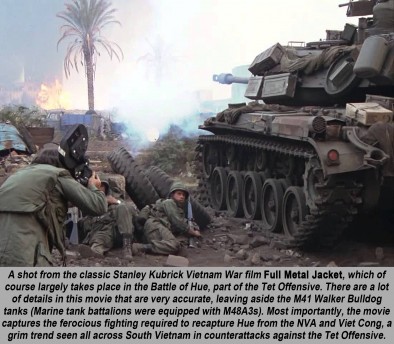
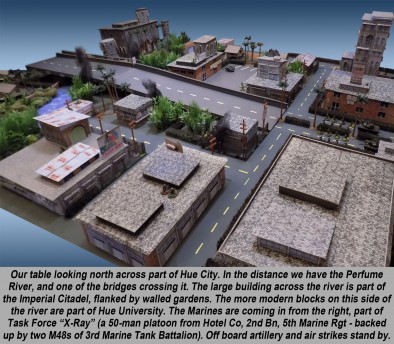
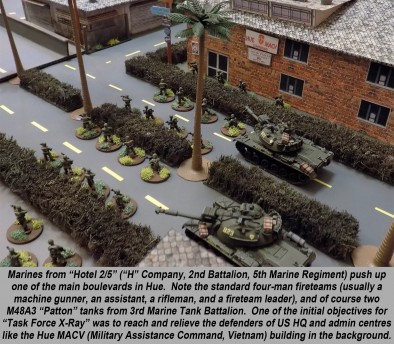
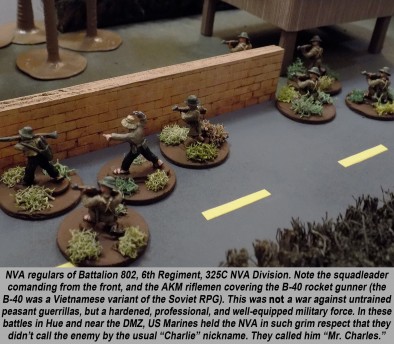
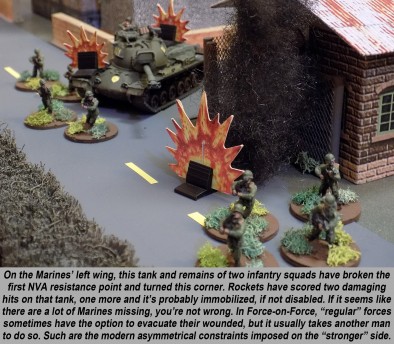
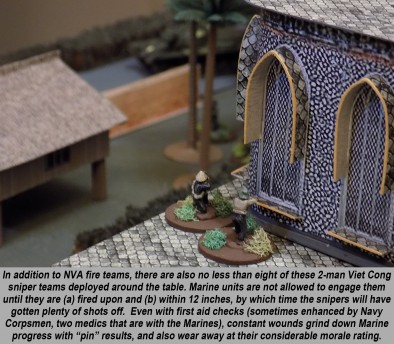
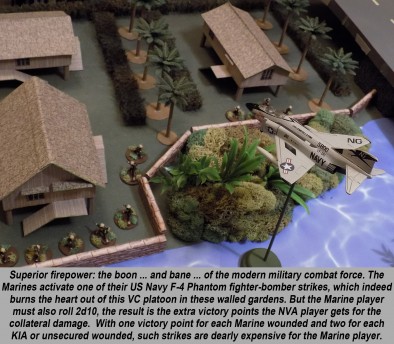
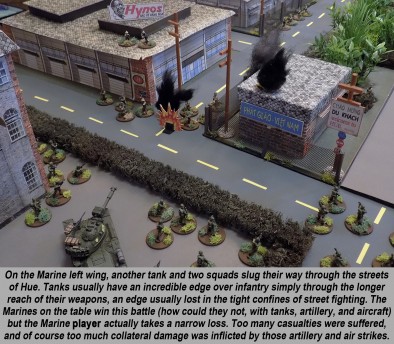
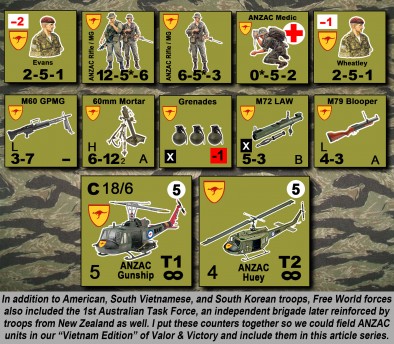
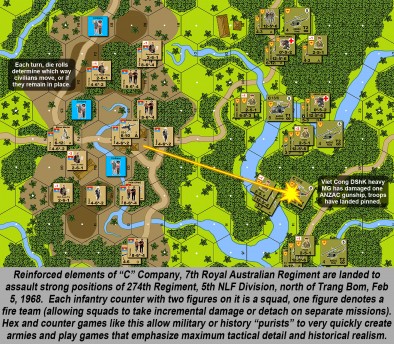
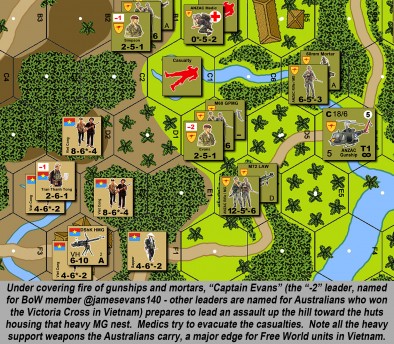
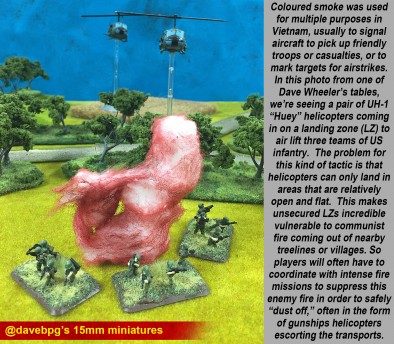
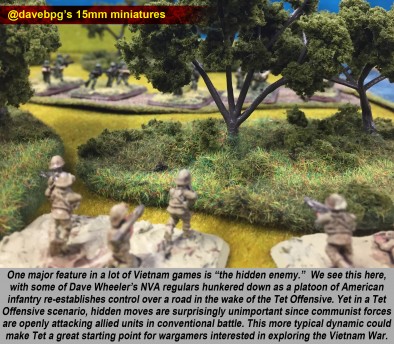


































Thank you very much for this series of articles. Is there any way you can share the books you used for the series, or have any reading recommendations? Cheers!
Thanks very much, @tzanerman – As far as sources go, I have chewed through Ambush Alley by Eric Hammel more the USMC “day in the life” perspective, and Platoon Leader by James R. McDonnough – although admittedly that last one only after I saw the movie by the same name back in the 80s. Kind of a terrible movie, but the book is much better. 😀 The “Vietnam – It’s Time to Start Your Tour of Duty” support thread has these same suggestions plus a lot more by other community members, books I haven’t read or even heard of, admittedly.… Read more »
Congrats. Again another well done, part of this article series.
Thanks very much, @andre77 ! We should come back and do an “End in Vietnam 1972-75” series one of these days so we can get that massive NVA army of yours, especially all that armor, on the table! 😀
That would be a sight 😀
Great read – as always – @oriskany .
Thanks very much. @bothi ! My poor little two USMC M48A3s would look so sad against the @andre77 ‘s massed T54/55s, T34s, ZSU-57-2s, and PT-76s! 😮 !!
A great look at Hue City and nice to see information on units of other allies armies. Well done!
Thanks very much, @pslemon ! 😀 Found a great .pdf that was very helpful re: the research for this battle.
http://www.marines.mil/Portals/59/Publications/US%20Marines%20In%20Vietnam%20The%20Defining%20Year%201968%20%20PCN%2019000313800_4.pdf
Thanks for another great article. My father was stationed in Alaska and worked as a B52 crew member during the early war in Vietnam. He talks a lot about the media and how he remembers them getting lots of things wrong. I look forward to your commentary on the same topic.
Thanks, @liono – it’s a tough call re: the media. A big piece of the Battles of Saigon, Hue, Khe Sanh, and other big Tet Offensive engagements went out live or nearly live (televised later that same day), completely uncensored. It’s a tricky conversation where the line is between “censorship” and “OpSec” (Operational Security) – or really how much of a war really should be exposed to the everyday public. As Secretary of State at the time Dean Rusk said (paraphrasing a little here) – what if there have been TV crews broadcasting live on Omaha Beach, of Anzio or… Read more »
I think that with Vietnam the USA definitely learned the lesson that control of what the media gets to see, hear and think about the war is very important. As such Rusk may have had a point, because I do think the public would have asked to have their boys brought back home (alive). Either that or they’d have to go on to fight the ‘evil reds’ … OTOH … if people were more aware of the true cost of war then they wouldn’t be so quick to call for one. It sucks that the ones that call for war… Read more »
Like Sean Bean says in Troy:
“War is young men dying, and old men talking.” 🙁
That sounds like they lifted it from the memoirs of a soldier from a different time, but the sentiment is the same.
Like Wifred Owen writes in the one that I never forgot since I read it :
…
If you could hear, at every jolt, the blood
Come gargling from the froth-corrupted lungs,
Obscene as cancer, bitter as the cud
Of vile, incurable sores on innocent tongues,
My friend, you would not tell with such high zest
To children ardent for some desperate glory,
The old Lie; Dulce et Decorum est
Pro patria mori.
// —
Or the irony from Colonel Kurtz in Apocalypse Now:
“We train our young men to drop fire on people.
But we won’t let them paint ‘f***’ on their airplanes …
… because it’s obscene?“
Excellent work as usual 😉
Thanks very much, @neves1789 . 😀 Had to do the Corps proud, after all. 😀 (And the ANZACs, of course)!
A great read @oriskany interesting to see the Australian’s being as strong in the tet raids thinking they were more involved during the operation hump (65) time’s.
Thanks, @zorg – Indeed, Australians were in Vietnam on a battalion+ level as early as 1966, and didn’t complete their withdrawal until 1971. Air units were in action as of 1964, and advisors were in-country as early as 1962 (Source: A Brief History of the Australian Forces in Vietnam – http://www.vietvet.org/aussie1.htm ) For the Tet Offensive, they were already “in the field” from their bases in the Phuoc Tuy province. This is partially because they were technically under the command of US “2nd Field Force” – commanded by Lt. General F. Weyand at Long Binh. Weyand was one of the… Read more »
I thought the Australian’s went in to help the French before the US but cant see any evidence?
I have never heard of that, but that certainly doesn’t mean it didn’t happen.
Want to see an Vietnam War historian squirm? Ask him point blank when American involvement in Vietnam started. Watch him dance in his seat. 😀
lol, it may have been just advisers?
I honestly don’t know, @zorg. Definitely possible. I always have issues when trying to prove that something “didn’t” happen or such-and-such “wasn’t there.” Statistically speaking, it’s always harder to prove a negative than a positive.
You hooked me when you mentioned the bush, although I would recommend always burying oneself in the bush when the opportunity presents itself.
Indeed, @raglan – that’s Rule #1 in “Oriskany’s Laws of War.” 😀
Make love, not war, that’s Raglan’s 1st rule these days.
Those new minis in the Vietnam support thread look awesome! 😀
As far as “make love, not war” goes …
I’m afraid I’m too old for the latter, not quite too old for the former … so you and I are probably on the same page. 😀
Great installment @oriskany. Thanks for the name sake counter. I found out something interesting and scary about Dien Bien Phu while looking at the political side. The French had formally requested the use of tactical nuclear weapons when the writing on the wall said which way this battle was going, thankfully the U.N. Security Council hit that one on the head. If it was approved I hate to imagine how fast Tac Nukes would be on the conventional weapons list. For me Tet was the beginning of the end on what could be achieved in Vietnam. Being what we would… Read more »
Thanks, @jamesevans140 – Thanks for the namesake counter No worries at all, sir. 😀 I should note (for everyone) that in the Australian counters I made for Valor & Victory “Vietnam Edition” – note the top commander (-2 in upper left, that “-2” is a bonus) is named “Evans” for JamesEvans140 – the “-1” commanders are named for Australians who won the Victoria Cross in Vietnam. The French had formally requested the use of tactical nuclear weapons when the writing on the wall said which way this battle was going. Yes, this was Operation Vulture. We touch on is very… Read more »
Great Work. I have always found city fighting much “scarier” than jungle fighting. Which is of course ridiculous as I have never actually done either. However it always struck me a much more difficult feat to win a fight in a city. Now, add in the constraint of not being able to damage that city, and you have reached a new level of WTF.
Looking forward to next week.
Thanks, @gladesrunner – urban combat indeed soaks up infantry units to ridiculous levels of troops density, and that many people with guns trying to kill each other, forced into engagement ranges that short, with little or no warning where the other side is until it’s practically too late . . . The increasing proportion of battles, campaigns, and warfare that are / is carried in dense urban environments is another worrying trend on modern warfare. In previously “horrific” wars like the American Civil War and World War I, urban combat used to be the exception. In World War II, Korea,… Read more »
What an interesting and great part IV of this incredibly splendid series. The idea with the collateral damage and victory points gained for the PAVN/NLF side is quite realistic and kind of captures effects of moral on victory well. Do you also have victory points ideas for recovery and care of wounded US soldiers other than those mentioned in the Flames of War rule set (the old one: I haven´t got the new “´Nam” book yet)? How many fireteams were in a standard company, f. i. the H company you mentioned in one of the captions of the pictures? I… Read more »
Great questions as always, @jemmy ~ Honestly, davebpg is the expert on FoW Vietnam, so I’m deferring to him (and players like Bothi and Andre77 and Jamest123) regarding how casualties work in FoW Vietnam. In Valor & Victory it varies by scenario, but we’re usually looking at 3 VP for a “secured” US/Allied casualty, 6 VP (double cost) for unsecured (unevacuated by the end of scenario turns or, God forbid, overrun by VC/NVA). In Force on Force, “regular” armies really need to evacuate / care for casualties because they remain a burden on teams in which they occur. Units with… Read more »
@oriskany :
why were the US troops not allowed to shoot at snipers at distances greater than 12″ ?
Was it to simulate the fact that they are hidden and not make it too easy to shoot at them with heavy weapons ?
Full Metal Jacket movie does show how nasty a single sniper can be.
You can definitely see how effective a few snipers can be in delaying the enemy advance.
Great question, @limburger , and I actually screwed this up. It’s supposed to be 10″ in FoF, not 12″. Basically, the range for enemy detection on a unit with the “stealth” ability (i.e., these snipers) = inches equivalent to the the detecting unit’s troop quality. The marines were TQ d10 (they roll d10s for most of their actions – hardened elite veterans), so the range on these spots and counter-fires should have been 10″, not 12″. Yes, even somewhat half-ass snipers like these TQ d8 snipers (they are NLF Viet Cong, after all, while the squads in the street were… Read more »
**ouch* only 10″ range within those rules? And them being snipers means they don’t even need to kill to be effective. I’m sure the army would have loved to have the opportunity to simply flatten the entire city block when allowed. Although such tactics make life even harder as it inevitably creates even more cover and places to hide as you mentioned in the Stalingrad series. I suppose the flaws are there because they thought it would make the scene less boring … despite the fact that in real life he would have been shot as no sane sniper would… Read more »
@oriskany these have been a great series of articles very informative. They have inspired at long last to paint up my Air Cav units for FOW!!
Thanks for your great reply @oriskany. You named the rest after VC holders which places me in the company of great men who’s shoulders are far greater than mine. So if you see me you would notice that I am very pleased if not a little embarrass (in a good way). Did you know that regardless of rank the NCO or officer they must salute the Victoria Cross first regardless of the rank of the holder. It was 504 service men who were killed in Vietnam. The rest were non combatant, such as official media and the like. Nurses are… Read more »
Good morning, @jamesevans140 – Did you know that regardless of rank the NCO or officer they must salute the Victoria Cross first regardless of the rank of the holder. Actually I did not know that. We have the same rule here for the Medal of Honor, I did not know the same applied to Victoria Cross holders. Although I confess at first I was very confused by your post. “You were in the company of VC holders?” I called you a South Vietnamese communist guerrilla? Arggh, I’ve been writing these articles too long. =( Yeah, my sources say 521, but… Read more »
Try to keep things tidy I will reply to your reply from past 3 here so you don’t have to bounce around too much, @oriskany. Totally agree with what is or not Tet for this article series. You must be concise and avoid scope creep. This is doubly important with this war or you will get caught in the dark swamp this war was. Further the angle of the article must defer to the encouragement of wargaming the period of this offensive you have chosen. Concerning the dessert war. I have had the entire Osprey series on tactics for some… Read more »
@jamesevans140 – Try to keep things tidy I will reply to your reply from past 3 here … Definitely appreciate it. 😀 Concerning the desert war, I have had the entire Osprey series on tactics for some time I figured you would. 😀 I know tactics and doctrine are big areas of study for you. I just thought I’m mention it. We will most likely not play it out in chronological order as we will be using the FoW V4 1942 rules. I really do like the FoW v4 rules, at least in comparison to v3 and previous editions. I… Read more »
Here is a link to a documentary I was talking about concerning the terrorist attack in India.
https://m.youtube.com/watch?v=5dYrCC0D7e0
It is chilling how they were expecting live coverage and intended on exploiting it.
Awesome link, @jamesevans140 – I will check it out on my lunch hour (while compiling more graphics for the Vietnam Support Thread) 😀 Okay, I’ve found a little more on this “nuclear options in Vietnam” angle. First, Operation Vulture in 1954. Turns out this OpPlan DID include nuclear weapons from the start. The US JCS drew up a plan to break the French garrison out of the Viet Minh siege at Dien Bien Phu , including about 30 USAF bombers based in the Philippines to drop carpets of conventional munitions, and three would carry smaller-scale tactical nuclear weapons (I doubt… Read more »
Why paint me yellow that’s not what I mean take me away from the VCs and place me with THE VCs. 😉 After reading that I see it was a bit too ambiguous. I most definitely mean the guys with chunks of bronze cannon hanging on their chests. More Victoria Cross trivia for you. Britain, NZ and AU all have the same VC so any from these countries are required to salute any VC. With one slight exception in that in the 80s Australia produced it’s own the AVC and as far as I can tell looks the same, but… Read more »
@jamesevans140 – I like your “invasion” plan. Throw in some nights with Sophie Monk, Imogen Bailey, Adelaide Kane, Phoebe Tonkin, Nicky Whelan, and Teresa Palmer, and I’ll call my people over at the Joint Chiefs of Staff and see what I can do. 😀
What can I say done deal and we will throw in their sisters!
Nice. 😀
Great reply to the one I started on the other article. Although I had the book I greatly appreciate your taking the time to suggest a book for me, given how busy you are. I am on a little break at the moment. Tomorrow I should get the paints and building materials for DAK, 8th Army and for painting up and building of desert scenery. These are authentic modelling paints rather than the FOW paints that miss a slight pink tone to many of them. Then my airbrush will be unpacked from the move and out to good use. I… Read more »
@jamesevans140 – interesting to read what you post regarding the two sets of rules, I honestly didn’t know that. Granted, all my experience with v4 FoW was at the boot camp, where we were decidedly playing with the 1942 rules. I had no idea the other periods were actually separate rules systems? @aras and I have been playtesting our way through my “Vietnam Edition” of Valor & Victory. Our process sounds a lot like you describe. We decide, almost on a whim, who will play what side. We’ll toss some companies or battalions together and have at it. Who cares… Read more »
I am sure that BoW could get you a copy of the early and late war edition of V4 from Battlefront or even as the historical editor they might sent you a copy. Trust me they are a richer and fuller set of rules yet straight forward with the simplicity of V4 1942 and still covered in 102 pages. It’s product code is FW008. There is also the Special rules and warriors book that you can download for free, if you wish to use the V3 army list books and warriors. You can use the new V4 army books and… Read more »
Not a bad idea, @jamesevans140 – it’s just that our group doesn’t really do FoW at the moment (I’ve got @aras mostly hooked on Battlegroup … looking forward to the Torch release … and sometimes @gladesrunner tries Force-on-Force). Ironically, I have two copies of the FoW v4 42-43 book, one normal copy and then a signed copy by all the Battlefront staff, won for my “Second Alamein” win at the Boot Camp 24-foot mega-table. 😀 And I have two copies of the Special Rules and Warriors booklet. I got one at the Boot Camp, and apparently I wound up with… Read more »
Even if you don’t play it @oriskany, I believe you should get hold of a copy as history editor so that you are basically across the this other version for when people talk about it. At the least you will have a look at reference guide. You will find that in detail it easily matches Battlegroup but approaches war at a different level. I am not trying to convert you here. But you will be in a better place to comment from. With flames of war you buy the rules once and you get a free book with every new… Read more »
Thanks @jamesevans140 . An alternative solution would be you could write the an article series that focuses on FoW, or join my growing militia of contributors and collaborators. 😀 For instance, @davebpg is putting some FoW focus on Vietnam in Part 05. We may also have some FoW: Great War material coming up later in the year (no promises on that one, we’re definitely doing the series but not 100% on the systems to be used yet). The “dumbing down” I feel is actually one of the biggest improvements. In my opinion and in comparison to other systems, too many… Read more »
I forgot to ask how did you find Team Yankee @oriskany?
A tougher call on that one. In a word, I definitely liked it, but of course I have very little to compare it to. I called it back in 2015 and I think history has borne me out on this … Team Yankee was the “test balloon” for a general new FoW rules model to be tweaked and rolled out with v4 12-18 months later. I think you see a lot of the same DNA between the two systems. Meanwhile, the only games to which I can really compare Team Yankee are really not fair to Team Yankee. The original… Read more »
Thanks for your reply @oriskany. As far as writing anything that would have to wait until my productive time to free up. Just replying to your articles can be hard enough. I am still recovering from the move. When I stated the 504 deaths, I was not challenging your research. Just the AWM. After the latest Director of the AWM he has taken it in a touchy, feely, new age direction chasing a relevance for all. He has even had poppish anthem created for our Unknown Soldier that refers to him as a she. He has had official numbers changed… Read more »
Thanks @jamesevans140 – Indeed, you’ve probably written 10 articles’ worth just in replies! 😀 I perceived no challenge to my research re: the 504 Australian KIA. If anything, I was just admitting that I barely did any research on that particular point. In fact, I initially pulled the info from Wikipedia of all places. I know Wikipedia doesn’t have the best reputation for its reliability, and it deservedly so. But for “quick fact points” what I’ll sometimes do is go there, then follow the hyperlinks to the citations in their sources. If those sources pass the “sniff test” – then… Read more »
So would you recommend it as a secondary game say from our main FoW game. People seem to enjoy it. At the moment there is a lot of chat about post Korea combats. So if it keeps up sooner than later someone will say why don’t we wargame it. I still have old rules we used back in the day. First is Engage & Destroy by Chaosium, 1980. We used this for wargaming Vietnam in 20/25mm. But it is written for 20/25mm, 15mm, which is handy now, and Micro. The other is TACFORCE by GDW/GHQ. This set of rules are… Read more »
Aha, thank you. When you say GDW / GHQ, yes, I realized I was wrong above when I said GMT Microarmor. Of course I meant GHQ Microarmor. I know what you mean and agree 100% about older games. Personally I feel they stopped making good wargames in the late 1980s. Exceptions would be Battlegroup, Force on Force (itself now out of print, sadly), and Valor & Victory, although even this is kind of a “beer & pretzel” love letter to Avalon Hill’s 1980s ASL. Yeah, GDW did not play around when it came to detail. God, they made the best… Read more »
In think the best ‘modern game’s I’ve seen recently is Fistful of Tows 3
I’ll have to check it out, @torros – But for my money it’s still GDW Assault series, or, to move out of 1980s Europe, the Panzergrenadier series (I’ve tinkered with it in the 1967 Six-Day War, prep for last year’s 50-year anniversary series).
Thanks @torros. What is it like? Closer to the old detailed games or more like modern games were the game system basically embeds the detail. Like Team Yankee where it assumes you have the correct round loaded and always have enough of the right rounds.
It’s more of a command decision/spearhead type of rule set. So each infantry stand is a platoon
Thanks @torros, who makes A Fist Full of Tows 3?
Hmmm I think it’s fistful of tows. I’ve sent you a pm
Good God Awlmaaaah-tie, @torros – this .pdf is massive! I do like in the design notes on p. 179 where they say there were looking in some ways for a system not unlike First Battle. This is the GDW series that originally started with a “Team Yankee” game published in 1988 I think. I see where they also mention Assault, but wanted a different type of system. I can see that. In Assault you roll to spot, then to hit, then to penetrate . . . great for a small tactical game like Battlegroup, but not for a big regiment… Read more »
Shit, I never said thanks, @torros – this really looks like a great book and a very detailed system! 😀
@oriskany You get blown away with the detail in TACFORCE and then there is the advanced rule book that us just as thick as the so called basic rule book. Such as the effects of communication breakdown causing loss of command and re establishing both. Which is separate to the sections on communication and command control. In the campaign section there is maintenance of vehicles of the breakdown effects if this does not happen. With a M60A1 you have the .30 cal coax with 90 bursts, the .50 cal cupola with 20 bursts. For the 105 you have APDS, HEAT,… Read more »
Oh absolutely not, @jamesevans140 – one of my friends used to joke that “GDW” stood for “Goddamned Work” when it came to their game systems. I didn’t mind then because a lot of them come from the old 1970s AH wargames, so I’m familiar with the “DNA.” Coming into a GDW system “cold turkey,” though, yeah, might be daunting. Assault has a very similar system that you’re describing, except no tracking the MG ammo. Then again, each counter (and you’d have dozens or over a hundred) tracked a section or platoon. So you’re playing on the regiment / brigade level.… Read more »
I remember with GDW games is used to be buy the game then wait a couple of months for the erratta to be released which was the same size as the rulebook. 🙂
Too true @torros. I had forgotten that part of it. We used to wait for the second printing to avoid most of that.
I have had my head read and it doesn’t help. 😉
The same could be said for all of us, @jamesevans140 . 😀
@oriskany I haven’t played it but I do know people who have and they say it’s not over complicated once you get he basics down. I had intended to start it for WW2 as it would be less complicated than moderns
I sent this link to James but a nice Australian Chao has developed it to be played on hexes
It’s on the right hand side of the screen
http://tinytanks3mm.blogspot.co.uk
He must live near me. Same city and we use the same supplier.
If we’re sliding back to hexes and counters I will stick with The Arab-Israeli Wars (1956-73, with updates for 1982 “Peace for Galilee) for “cold war” era combat, and then this update to the PB PL AIW for the Gulf Wars I and II:
http://www.toshachminiatures.com/games.htm
Honestly, I don’t have a full set of the old GDW Assault rules, and I doubt I would track it down and re-learn the whole system again. I have too many games, minis, and writing projects on my plate, and I have to stick to games other players around me will actually play. 😀